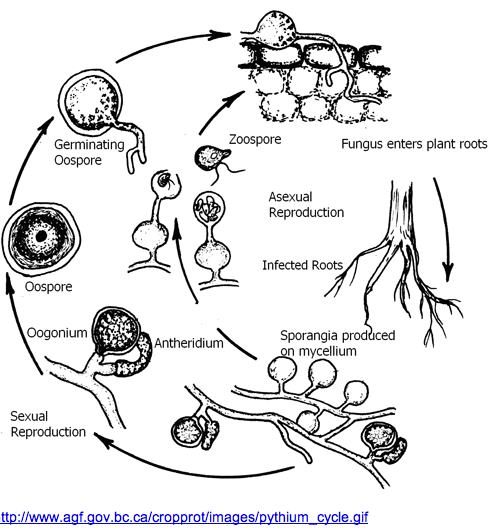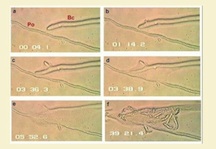Pythium oligandrum
Classification
Kingdom: Chromalveolata
Phylum: Heterokontophyta
Class: Oomycetes
Order: Pythiales
Family: Pythiaceae
Species
|
NCBI: Pythium oligandrum [1] |
'
Description and Significance
P. oligandrum is a nonpathogenic oomycete that can be utilized as a biocontrol agent to provide damping-off and root disease resistance to various soil born plant pathogens. It also ability to cannibalize other oomycetes such as Fusarium and Phytophthora, making it a crucial defense for the plant roots. Furthermore, this ability can be utilized to fight off fungal infections such as ringworm and athlete's foot.
Genome Structure
Describe the size and content of the genome. How many chromosomes? Circular or linear? Other interesting features? What is known about its sequence?
==Cell Structure, Metabolism and Life Cycle==
Pythium oligandrum has two distinctive life cycles. One of which is asexual and the other is sexual. In the asexual lifecycle, P. oligandrum exists as a zoospore. A zoospore is a flagellated cell containing genetic material. The zoospore of P. oligandrum is diploid and contains the full genome. In the case of P. oligandrum, the zoospore is an important life stage because of the zoospores ability to move through water via its flagella. When conditions are suitable, the zoospore undergoes mitotic divisions and matures. Pythium oligandrum exists in its sexual life stage about 20% of the time(1). This life cycle is characterized by thick walled oospores. Oospores are a result of the fertilization of oogonium by antheridium, which is the male sex organ of the organism. The maturation of the oospores leads to the production of mycelium and a mature organism capable or reproduction and completing the cycle. Oospores are characterized by their thick cell walls and are relatively large cells.
Pythium oligandrum is a eukaryotic organism. They were once thought to be a type of fungi, but they lack chitin and are currently categorized as a protist. Their oospores are spiny walled, which distinguished them from other species of Pythium. Their mature stage is multi-cellular and filamentous. P. oligandrum is found in the rizzoshephere. P. oligandrum is parastic and hetertrophic. Being a non-phtosynthetic eukaryote, I suspect that is uses, or can use oxygen as a T.E.A.
==Ecology and Pathogenesis==
Habitat: P. oligandrum exemplifies a symbiotic relationship within the rhizosphere of various plant roots such as tomatoes and sugar beet plants. This relationship consists of P. oligandrum inhibiting the pathogenic capabilities of various harmful oomycetes and so maintains the plants roots from foreign attack. In return P oligandrum will obtain the necessary nutrients from the plant roots to thrive. It's aggressive cannibalistic behavior can cause damping-off. This can potentially kill seeds because the organism attacks the first roots formed during germination. Furthermore, P. oligandrum is considered an “aggressive microparasite” that forms parasitc relationships with plants and other microorganisms. For the latter reason, it can actually be beneficial to plants because it can provide as a sort of defense from other plant pathogens esp. fungi. For this reason, P. oligandrum is a potential biocontrol agent. However, because it infects fungi it can ruin mushroom crops such as those crops of the common mushroom(2) (Agaricus bisporus)
References
1. "Review report for the active substance Pythium oligandrum M1." EUROPEAN COMMISSION HEALTH & CONSUMERS DIRECTORATE-GENERAL. Web. <http://ec.europa.eu/food/plant/protection/evaluation/existactive/M1.pdf>.
2. Godfrey et al. 2003. Identification of Pythium oligandrum using species-specific ITS rDNA PCR oligonucleotides. The British Mycological Society. 107(7):790-796. Science Direct. 21. April 2011.
3. Le Floch, G., Tambong, J., Vallance, J., Tirilly, Y., Lévesque, A. and Rey, P. (2007), Rhizosphere persistence of three Pythium oligandrum strains in tomato soilless culture assessed by DNA macroarray and real-time PCR. FEMS Microbiology Ecology, 61: 317–326. doi: 10.1111/j.1574-6941.2007.00348.x
4. Holmes, K. A., Nayagam, S. D. and Craig, G. D. (1998), Factors affecting the control of Pythium ultimum damping-off of sugar beet by Pythium oligandrum. Plant Pathology, 47: 516–522. doi: 10.1046/j.1365-3059.1998.00253.x
5. Reproductive life cycle picture: British Columbia: ministry of agriculture . Web. 21 Apr 2011. <http://www.gov.bc.ca/agri/>.
Author
Page authored by Thomas Fox and Fuad Hajiabdi, student of Prof. Jay Lennon at Michigan State University.
<-- Do not remove this line-->


